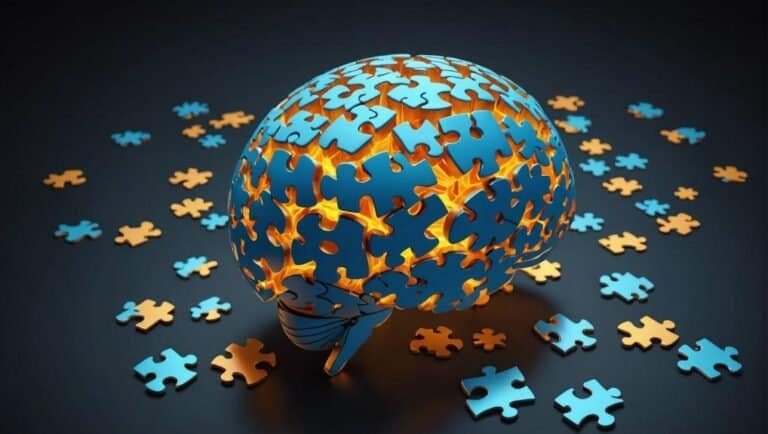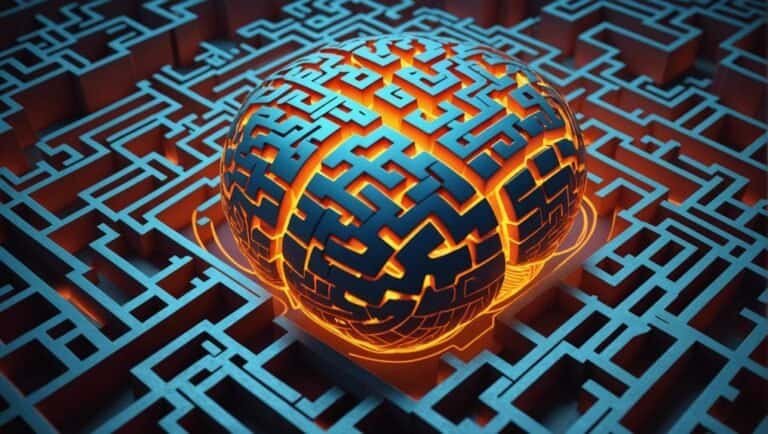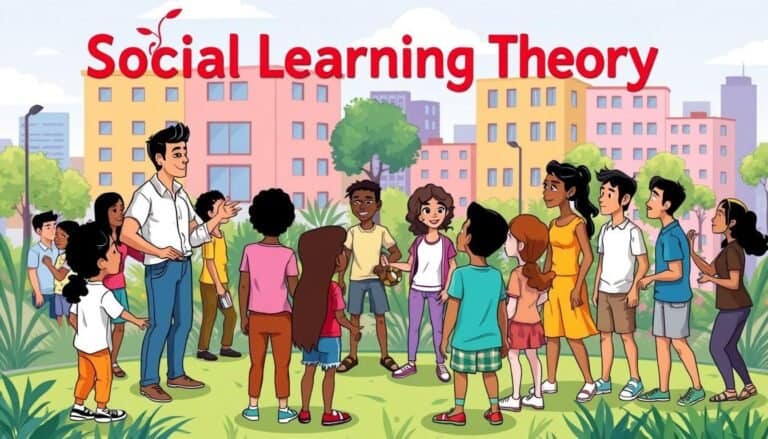Understanding The Halo Effect in Psychology
Have you ever noticed how some people seem more confident and smart just by how they look? This is the Halo Effect, a key bias in how we see and judge others. It was first talked about by psychologist Edward Thorndike. He found that a good first impression in one area, like being good-looking, can change how we see other qualities like being smart or honest.
In today’s fast-paced world, knowing about this bias is crucial. Studies in 45 countries show that attractive people are often seen as more friendly and trustworthy. This bias also affects our views in school and work, where popular students get better grades, not just because they’re smart.
This effect is important in many areas, like making decisions in courts or choosing brands. It shows how our first impressions can deeply shape our views of others and even society.
Key Takeaways
- The Halo Effect can greatly change how we see others based on their looks.
- Studies link being seen as attractive with being seen as having good traits.
- This bias affects many areas, like education and marketing.
- Knowing about the Halo Effect can help us make fairer decisions in work and court.
- It shows how our first impressions deeply influence our views of people.
What is the Halo Effect?
The Halo Effect is a fascinating cognitive bias that changes how we see people, brands, and products. It happens when our overall impression of someone affects how we see their specific traits. This leads to biased evaluations. Knowing about the Halo Effect helps us understand its role in various areas.
Definition and Explanation
The Halo Effect is linked to the idea that “what is beautiful is also good.” Studies show that when we find someone attractive, we think they are smart and kind too. This isn’t just for people; it also applies to products and brands. For example, a new product might get a good review because of a positive experience with a similar brand.
Historical Background
Psychologist Edward Thorndike named this bias in 1920 while studying military officers. He found that good-looking people often got high marks in many areas. Over time, research showed how this bias affects education and work, helping us understand its wide impact.
Relation to Cognitive Bias
The Halo Effect is a key example of how our first impressions shape our views on other qualities. It leads to unfair judgments based on looks. For example, teachers might expect more from attractive students. In marketing, using the Halo Effect can greatly influence how customers act, showing its wide reach.
| Aspect | Description |
|---|---|
| Definition | A cognitive bias where overall impressions influence perceptions of specific traits. |
| Historical Context | Coined by Edward Thorndike in 1920 during evaluations of military officers. |
| Examples | Physical attractiveness leading to perceived intelligence; positive brand perceptions. |
| Applications | Used in education, marketing, and personal evaluations. |
The Origins of the Halo Effect
Edward Thorndike first explored the halo effect in the early 1900s. His work showed how certain traits can change our opinions on others. He wanted to know how one good trait could affect our view of another.
Edward Thorndike’s Research
In 1920, Edward Thorndike introduced the halo effect. He looked at how people judge others on different traits. He found that if someone was seen as good at leadership, people often thought they were also smart and had good character.
This showed how looks and other traits can shape our opinions. It helped us understand the halo effect as a real bias in how we judge.
Significant Studies in the Field
After Thorndike, many studies built on his work. They found that people think more of those who are seen as attractive, whether at work or in school. Being attractive can even affect how much you earn and get promoted.
For example, a study showed that good-looking waiters got more tips. These findings show how the halo effect touches many parts of life. It changes how we see people based on just one good trait.
| Study | Findings |
|---|---|
| Thorndike (1920) | Introduced the halo effect, linking high ratings in one trait to others. |
| Rosenthal & Jacobson (1968) | Teachers’ expectations of student performance correlated with students’ attractiveness. |
| Parrett (2015) | Attractive restaurant servers earned significantly more in tips compared to others. |
| Judge, Hurst & Simon (2009) | Physical attractiveness impacted income through educational attainment. |
| Landy & Sigall (1974) | Competence ratings of authors differed significantly based on perceived attractiveness. |
How the Halo Effect Functions
The halo effect works by making one good trait overshadow others. This makes judging people, brands, or situations easier. It’s a quick way to make big judgments based on one positive trait.
This thinking leads to quick judgments that might not be fair. For example, someone’s good looks might make us think they’re also smart or kind.
Mechanisms of Cognitive Bias
Cognitive biases play a big role in the halo effect. These biases shape how we see things and make decisions. They help us judge others quickly, often ignoring the facts.
For instance, a candidate who looks great might seem more capable, just because of how they look. This bias makes us focus on quick judgments over solid evidence.
Immediate Judgment Discrepancy
This quick judgment can affect many areas, like hiring or marketing. For example, teachers might think well-dressed students do better in school, even if their grades don’t show it. This can lead to wrong assumptions that affect people’s lives.
| Area of Impact | Example of Halo Effect |
|---|---|
| Workplace | Attractive employees may receive promotions based on looks rather than skills. |
| Education | Teachers favor attractive students, affecting grades and attention. |
| Marketing | Consumer trust in products endorsed by attractive individuals increases sales. |
| Politics | Voters may judge candidates based on looks instead of their qualifications. |
| Legal System | Judicial decisions swayed by a defendant’s appearance can lead to unfair outcomes. |
Examples of the Halo Effect in Everyday Life
The halo effect shows up in many parts of our daily lives, shaping how we see and judge things. Here are some examples where this effect is clear.
Physical Attractiveness Stereotype
One common way the halo effect works is through the physical attractiveness stereotype. People often link beauty with good qualities like being smart and kind. For example, a study found that good-looking women waitresses made about $1200 more a year in tips than those who were less attractive. Also, customers gave more tips to pretty female waitresses than to men or less attractive women, showing how looks affect money matters.
Impact in Educational Settings
Education is also touched by the halo effect. Teachers often expect more from students who are seen as attractive, which can change how well they do and how they interact. Research links student looks to grades, showing that first impressions can lead to better marks. This bias also affects classroom interactions, where a positive first view of a student can mean better grades and more chances for success.
Influence in Professional Environments
The workplace is another place where the halo effect is strong. Being friendly and likable can make people overlook a person’s real skills. For instance, bosses might rate workers higher based on how they seem rather than their actual skills. Quick judgments about high-ranking people can lead to special treatment without real reason, showing how the halo effect can affect promotions and reviews.
| Context | Influence of Halo Effect | Examples |
|---|---|---|
| Restaurants | Increased tips for attractive servers | Attractive women earning $1200 more in tips |
| Education | Heightened expectations and performance for attractive students | Studies linking attractiveness to better grades |
| Workplace | Skewed performance ratings based on likability | Favoritism towards charismatic colleagues |
The Halo Effect in Marketing and Advertising
The halo effect deeply affects how we see and act towards brands. It changes how we judge brands based on our first feelings. Things like branding, celebrity endorsements, and how we behave as consumers play big roles in this.
Branding Influence
Branding greatly shapes what we think of a brand. A positive brand image can make us like all its products more. For example, if we love a product from a brand, we’ll probably like other products from it too.
Studies show that feeling a strong bond with a brand can make customers worth 306% more over their lifetime. This shows how good branding can make us loyal and keep coming back.
Celebrity Endorsements
Celebrity endorsements use the halo effect well. Famous people make us think certain things, and brands use this to their advantage. Research from Harvard Business School shows that sales go up when athletes do well, proving the power of these endorsements.
Using the fame of these celebrities helps brands tell a story that touches their audience.
Consumer Behavior and Decision Making
The halo effect also changes how we make choices. Research says 80% of us become loyal to a brand after having good experiences with it. Also, many of us like to buy from companies that share our values, as found by Porter Novelli.
This emotional bond makes us tell others about our good experiences, helping the brand grow. This can make a brand more popular and loyal customers.
| Statistic | Finding |
|---|---|
| Positive Brand Association | Olympic sponsors see a 117% increase in positive views among fans. |
| Community Support | 57% of consumers support brands that contribute to local communities. |
| Trust in Recommendations | 81% trust family and friends over company claims. |
| Consumer Preference | 60% prefer to buy from brands supporting charitable causes. |
| Loyalty Development | 80% of customers develop loyalty through positive brand experiences. |
Consequences of the Halo Effect
The halo effect has big impacts on how we judge people and groups. Knowing about these effects helps us make better choices in our personal and work lives.
Effects on Personal Judgments
At a personal level, the halo effect changes how we see others. If someone looks good or seems charming, we might overlook their flaws. This can lead to unfair judgments, where we miss the whole picture.
Implications for Business and Organizations
In the workplace, the halo effect can mess up hiring and judging performance. Companies might focus too much on one good trait, like a degree or confidence. This can lead to unfair benefits for some people and hurt diversity efforts.
To fight these issues, companies use methods like anonymous applications and clear interview scores. This helps reduce the halo effect, making hiring fairer and more accurate.
| Aspect | Positive Impact | Negative Impact |
|---|---|---|
| Personal Judgments | Broadens understanding of capabilities | Leads to biased assessments |
| Hiring Practices | Enhanced first impressions | Distorts true candidate evaluation |
| Organizational Dynamics | Fosters positive workplace culture | Encourages favoritism and inequity |
The Halo Effect and Its Opposite: The Horn Effect
The horn effect is the opposite of the halo effect. It shows how negative traits can change how we see others. This idea tells us how our first impressions can lead to biases in making decisions. These biases affect how we judge people in hiring and social situations.
Comparison of the Two Biases
The horn and halo effects both change how we see people based on their first impression. The halo effect makes us think positive traits mean someone is good in all ways. The horn effect, on the other hand, makes us think a single negative trait defines someone’s character.
For instance, being late to an interview can make us overlook a candidate’s skills and experience. Here’s a table that highlights the main differences between these biases:
| Bias | Definition | Impact on Judgments |
|---|---|---|
| Halo Effect | Positive evaluation based on a favorable trait. | Overestimation of capabilities and positive attributes. |
| Horn Effect | Negative evaluation due to an unfavorable trait. | Underestimation of abilities and overlooks positive attributes. |
Real-Life Scenarios of the Horn Effect
In real life, the horn effect shows up in many places. For example, in court, how a defendant looks can affect how jurors decide guilt or innocence. Attractive people are often seen as more trustworthy, while those who are not may be judged unfairly.
This bias also affects hiring, where people with names that sound foreign may be less likely to get interviews. This shows we need to work on overcoming biases to make fairer decisions.
Impact of the Halo Effect on Job Performance Assessments
The Halo Effect greatly affects how we judge job performance, leading to biases in evaluations. It makes employers see employees in a better light because of one good trait. This can change how we see their overall performance.
Research on Performance Reviews
Many studies show how the Halo Effect distorts performance reviews. Recruiters might ignore a candidate’s flaws because of their looks or charm. Traits like being attractive or charismatic can make a strong first impression. But, this can lead to overlooking important skills.
Research points out that attractive employees might be seen as more competent and smart. This can make their performance seem better than it really is.
Halo Effect’s Role in Promotions and Hiring Decisions
The Halo Effect is key in promotions and hiring. A strong first impression can make someone stand out over others, even if they’re not the best fit. This can lead to missing out on diverse talent.
Recruiters might pick someone based on their education or confidence, not their actual skills. To avoid these biases, using structured interviews and diverse hiring panels can help. This makes evaluations fairer.
| Impact of Halo Effect | Consequences |
|---|---|
| Biased Assessments | Missed talent opportunities and inflated evaluations |
| Swayed Impressions | Reduced diversity and biased decision-making |
| Single Trait Influence | Flawed hiring decisions and overlooking important qualifications |
How to Mitigate the Halo Effect
To fight the halo effect, we need to use special strategies. These help reduce bias in making decisions and evaluating things. Using cognitive debiasing is a great way to lessen bias, especially at work. It helps make evaluations fairer and more accurate.
Cognitive Debiasing Techniques
Cognitive debiasing helps people spot and fix their biases. Here are some important methods:
- Slowing down to think more before making quick judgments.
- Reflecting on past choices to learn from them.
- Looking at different options to get a full view.
Encouraging Objective Evaluations
In the workplace, making evaluations fair helps fight the halo effect. Here’s how:
- Using clear criteria based on things you can measure, like:
| Evaluation Criteria | Importance |
|---|---|
| Behavioral Profile | Checks if someone fits the company’s culture |
| Background/Experience | Looks at if someone has the right skills |
| Key Competency | Checks if someone has the skills needed for the job |
| Goal Alignment | Makes sure goals match up with the company’s goals |
| Positive Impression | Keeps in mind the effect of first meetings but doesn’t let it cloud judgment |
Getting feedback from different people can shake off wrong assumptions. Using things like rubrics and scores makes hiring and reviews fairer. This cuts down on biased decisions.
Understanding the Broader Implications of the Halo Effect
The Halo Effect greatly affects how we see ourselves and our confidence. People often judge their abilities by how others see them. This is more common on social media, where we compare ourselves to perfect images online.
This leads to high expectations and pressure to be like those ideal images. It can lower our self-esteem.
Effects on Self-Perception and Confidence
Being good-looking can make people think you’re better in many areas, not just looks. This affects how we see ourselves and can lead to a cycle of seeking approval. Feeling confident often depends on what others think of us.
When people make many daily choices, it’s easier for bad judgments to happen. This makes it harder to know ourselves well.
Halo Effect in Social Media Contexts
Social media shows the Halo Effect clearly, making looks and brand image very important. People judge apps and ads by how they look, not just how they work. A study showed a pretty app was seen as easier and safer just because of its login page.
Brands can look better by doing good social work. But, one bad customer interaction can change people’s minds fast.
| Aspect | Positive Halo Effect | Negative Halo Effect |
|---|---|---|
| Physical Attractiveness | Linked to positive traits like charisma and intelligence | Judgments based solely on looks can undermine true capability |
| Social Media | Increased engagement and validation for positive portrayals | Heightened pressure to maintain an idealized image |
| Brand Perception | Corporate social responsibility efforts positively impact consumer trust | Poor communication can damage brand loyalty and reliability |
Conclusion
Understanding the Halo Effect is key to dealing with cognitive biases in our daily lives. This effect, first spotted by Edward L. Thorndike in the early 1900s, shows how our opinions of people can be swayed by their looks. This leads to a mix of good or bad feelings that aren’t based on their true skills.
This bias affects more than just our opinions. In marketing, brands like Nike use it to make a good name for themselves. But, as seen with Jared and Subway, a bad experience can harm a brand’s image. This shows how careful businesses need to be.
Knowing about the Halo Effect helps us and companies avoid its pitfalls. It leads to fairer judgments that focus on real skills, not just looks. By being mindful in our choices, we can make a fairer world. This way, we let true insights guide our views of others.







